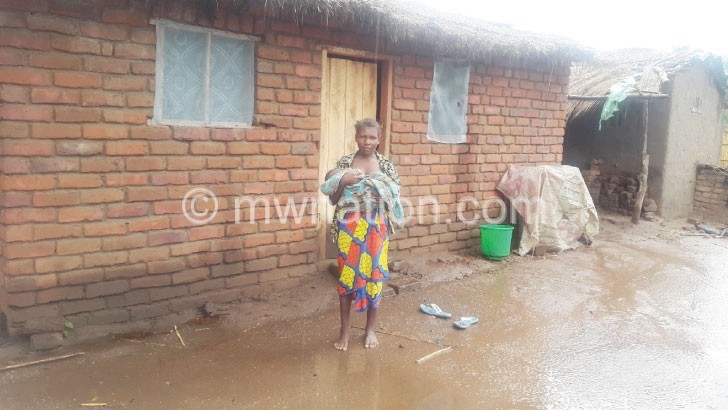Finding new methods to reduce malaria in Majete
Estele Kondwani, a young mother of one from Bwalo Village, Traditional Authority (T/A) Kasisi in Chikwawa District, recalls of days when malaria topped the list of illnesses affecting her household.
“Almost every month, someone from my household was visiting the hospital [Chikwawa District Hospital] for malaria. If it was not me or the baby, it was my husband,” she says.

However, the story is different now. Kondwani says the last time a member of her family visited the hospital for malaria is around January this year, before her family started sleeping under a mosquito net.
“Apart from sleeping under a mosquito net, our house was also improved. People who introduced themselves as researchers conducting a malaria research in Majete area came and helped us to close the eaves [the part of a roof that meets the walls of a building]; they had large openings which mosquitoes were using to get into the house.
“The researchers also gave us mesh screens to put on our windows because sometimes the mosquitoes were entering the house using the windows. In the past, by 4pm, the house would be full of mosquitoes, waiting to feast on us once we slept, but not anymore,” says Kondwani.
Sharing Kondwani’s sentiments are people in Gawanani Village in T/A Chapananga area in the same Chikwawa District. They say they were also visited by the researchers and they noticed malaria cases have gone down after they did as advised, says Village Head Gawanani.
“They gave us a biological agent to treat all standing waters that were breeding zones for mosquitoes around our homes; they encouraged us to sleep under mosquito nets which were distributed by the government; and they helped us to improve our houses by closing open eaves and putting mesh wire on the windows in order to stop mosquitoes from entering our houses,” he says.
He adds that previously people in his area were vulnerable to malaria, hospital visits were on a daily basis and children were the worst affected. Things have changed now; a month is passing without any member of his village reporting sick due to malaria.
Health experts say malaria is the biggest cause of morbidity and mortality in Malawian children under the age of five. The disease claims the life of one child every two minutes, according to the World Health Organisation (WHO).
WHO estimates that in 2015 malaria caused 212 million clinical episodes and 429 000 deaths worldwide. Most of these deaths were young children from the African Region.
As malaria cases continue to devastate Malawi and worldwide, the Kondwani Family and people in Gawanani Village are better off now. This is because they are participants in a five-year (2014-2018) collaborative malaria research project being conducted in Majete Wildlife Reserve perimeter in Chikwawa.
Focusing on community involvement, the project seeks to find new methods that communities could use themselves to help lower the burden of malaria among their families and communities.
The research project is being conducted by University of Malawi’s College of Medicine in collaboration with two Dutch Universities (Wageningen University and Research and Amsterdam University), the Malawi Liverpool Wellcome Trust (MLW), African Parks, The Hunger Project and the Ministry of Health (MoH).
According to Monicah Mburu, a PhD student from Wageningen University who is working on the project, 25 000 locals drawn from 65 villages near the wildlife reserve are currently participating in the project, with the project planning to expand to include 100 000 people by the end of 2018.
She says the villages were divided into four groups and the research is comparing four different combinations of malaria control methods.
The methods are: removal of standing water that provides a breeding ground for malaria mosquitoes, or use of a biological agent to treat the water where the water cannot be removed; closing of open eaves and putting mesh screens on windows; and lastly, the current government recommended approach, to use of a combination of mosquito nets and seek treatment as soon as children fall sick with a fever.
“The first group is using the combination of mosquito nets and medication and the second one is using the combination of mosquito nets and medication as well as treating standing water in their villages.
“The third group is using the combination of mosquito nets and medication and house improvement, that is closing of open eaves and putting mesh screens on windows whereas the last group is using all three methods being tested. The intention is to actually find the best combination of methods at the end of the project,” says Mburu.
The other side
However, while the Kondwani Family and people in Gawanani Village notice they have less mosquitoes in their homes and fewer cases of malaria, the Lilongwe Family of Chibwalizo Village in the area of T/A Chapananga tell a different story. This family is among the group which is just using a combination of mosquito nets and seeking treatment when sick with fever.
Bertha Lilongwe, the mother of the house, says most hospital visits from her home are malaria-related. She adds that they received bed nets and were advised to visit the hospital every time we have malaria symptoms.
“We were told about the new methods but we were not assisted to treat the standing water surrounding our house and they did not assist us to close the eaves’ openings or put wire mesh on our windows. In fact, the researchers told us to leave these the way they are. We usually have a lot of mosquitoes in the house,” says the mother of two.
Tumaini Malenga, another PhD candidate from CoM working on the project says the main challenge is to help households such as the Lilongwe’s to understand that, because this is a research project, they cannot yet use those other new methods that are being used in nearby villages.
“But we are trying as much as possible to mobilise the community and make them see the future benefits of the research project. We are also involving them at each and every stage, for instance, we recruited at least two individuals from each of the 65 villages and we trained them about the research project and the importance of community participation,” says Malenga.
Why the research
Malenga said this research project is needed because the researchers do not know for certain if these two new methods–communities managing their own standing water and house improvements–work well, and if communities can maintain them over time. These methods are not yet recommended as best practice by public health policy makers, she adds.
As families such as the Lilongwe’s are encouraged to carry on with the methods being used by their assigned groups, the research team is visiting households in all the involved 65 villages to test people for malaria and collect mosquitoes with traps in order to determine the best combination of methods.
In May 2018, the research team will compare the results from each group of villages, after which the best combination will be rolled out to all 65 villages near the Majete wildlife reserve.





